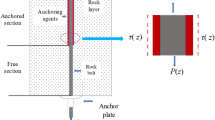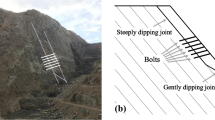Abstract
When anchors are installed along or close to discontinuity surfaces in a jointed rock slope, it is very difficult for them to bond to the rock mass. The correct orientation of rock anchors should be selected for precise design. Hence, using stereographic projection to reveal the geometrical relationships among the slope face, discontinuities, and anchor bolts is vital. In support measures, the inclination of the anchor bolt is affected by many factors, such as the feasibility and difficulty of construction. Therefore, it should be based on the analysis results of stereographic projection. This study aims to determine the most suitable anchor inclination angle based on geometrical information using stereographic projection techniques to provide the stability to excavation slopes. Remarkable stereographic projection images such as “an opened umbrella” and “an upside-down umbrella” for planar and toppling failures, respectively, were obtained. The most suitable anchor inclination angles for both planar and toppling failures were determined by investigating the largest acute angle between the discontinuity plane and the anchor bolt on the stereographic projection. Additionally, a computer program based on basic geometric relations was developed to determine the most suitable inclination angle for rock anchors installed perpendicular to the slope face. Using both stereographic projection techniques and computer software, the most suitable anchor inclination angles for planar slides and toppling failures were determined to be 17° and 11°, respectively. However, this method may not be reliable in determining the suitable inclination angle of rock anchors in highly fractured rock masses.



















Similar content being viewed by others
References
Agustawijaya DS (2007) The uniaxial compressive strength of the soft rock. Civil Eng Dimen 9(1, 9):14
Atkinson RH, Bamford WE, Broch E, Deere DV, Franklin JA, Nieble C, Rummel F, Tarkoy RJ, Van Duyse H (1978) Suggested methods for determining the hardness and abrasiveness of rocks. Int J Rock Mech Min Sci Geomech Abstr 15(3):89–98
ASTM D 2938 – 95 (1992) Standard test method for unconfined compressive strength of intact rock core specimens. Rock Testing Handbook
ASTM D 3967 – 95a (2004) Standard test method for splitting tensile strength of intact rock core specimens (Brazilian method). Rock Testing Handbook
ASTM C1604 / 1604 M -05 (2019) Standard test method for obtaining and testing drilled cores of shorcrete. Rock Testing Handbook
ASTM D 5607–02 (2019) Standard test method for performing laboratory direct shear strength tests of rocks specimens under constant normal force, p. 1–12
Barley AD, Windsor CR (2000) Recent advances in the ground anchor and ground reinforcement technology concerning the development of the art. In: Proceedings of the international conference on geotechnical engineering 1048–1094
Bell FG (1992) Engineering in rock masses. Oxford [England]: Butterworth-Heinemann. Edited by F. G. Bell
Brown ET (1981) Rock characterization, testing & monitoring: ISRM suggested methods, Editor. Published for the Commission on Testing Methods, International Society for Rock Mechanics. Oxford; New York: Pergamon Press
BS 8081: UDC 624.137.6 (1989) British standard code of practice for ground anchorages, British Standards Institution, 389 Chiswick High Road, London, p. 180
Canadian Geotechnical Society (1978) Canadian foundation engineering manual. Quebec, Canada: Part – 4. In: Scott JD. Editor, Excavations and Retaining Structures
Celeb Z, Kumbasar N (1996) 1996. Sema Press, Concrete structures. İstanbul (In Turkish)
D.E.U. (2014) Anchoring applications on the foundation excavation slope to prevent the mass movements in Gümüşpala district – İzmir. Dokuz Eylul University (D.E.Ü), Engineering Faculty
Goodman RE, Bray JW (1976) Toppling of rock slopes. Proceedings of the ASCE Specialty Conference on Rock Engineering for Foundations and Slopes, Vol. 2, American Society of Civil Engineers, New York
Hobst L, Zajic J (1983) Anchoring in rock and soil. Elsevier Sci. Publishing Co., Amsterdam
Hoek E, Bray JW (1981a) Rock slope engineering, Revised, 3rd edn. The Institution of Mining and Metallurgy, London
Hoek E, Bray JW (1981b) Rock slope engineering. London, Inst Min Metall
Kahraman S (2009) The effect of rock classes on the relation between uniaxial compressive strength and point load index. Bull Eng Geo and Environ 68(3):345–353
Koca MY, Kıncal C (2004) Abandoned stone quarries in and around the Izmir city centre and their environmental impacts – Turkey. Eng Geo 75(2004):49–67
Koca MY, Kıncal C, Aslan AT, Yılmaz HR (2011) Anchor application in Karatepe andesite rock slope, İzmir – Turkey. Int J Rock Mech Min Sci 48(2):245–258
Littlejohn GS (1970) Soil anchors. In: I.C.E. Conf. on Ground Engineering, London, 33–34 and discussion 115–120
Littlejohn GS (1972) Some empirical design methods employed in Britain. In: Questionnaire on Rock Anchor Design, Geotechnics Research Group, Dept. of Eng., University Aberdeen (unpublished)
Littlejohn GS, Bruce DA (1977) Rock anchors: state of art. Foundation Publications, Essex, England
Littlejohn GS (1979b) Design estimation of the ultimate load holding capacity of ground anchors, In: Symp. On Prestressed Ground Anchors, The Concrete Soc. of South Africa, Johannesburg
Nadi B, Tavasoli O, Kontoni DPN, Tadayon A (2019) Investigation of rock slope stability under pore-water pressure and structural anisotropy by the discrete element method. Geomech Geoeng 16(6):452–464
Piteau DR (1970) Geological factors significant to the stability of slopes cut in rock. Proc. Symp. Planning Open Pit Mine; Johannesburg, Amsterdam: A.A. Balkema
Ragan DM (2009) Structural geology (an introduction to geometrical techniques). Cambridge University Press, New York
Shaqour F (2006) Ground anchors in an aggressive hydro-environment. Bull Eng Geol Environ 65:43–56
Ulusay R, Hudson JA (2007) The complete ISRM suggested methods for rock characterization, testing and monitoring: 1974–2006. Suggested Methods Prepared by the Commission on Testing Methods, International Society for Rock Mechanics, Compilation Arranged by the ISRM Turkish National Group Ankara, Turkey, Ankara, Turkey: Kozan Printing house
Wyllie DC (2018) Rock slope engineering, Civil Applications, 5th Ed. Taylor & Francis eBooks, p. 620
Xanthakos PP (1991) Ground anchors and anchored structures. A Wiley-Interscience. Publication John Wiley & Sons, Inc, New York, p 685
Author information
Authors and Affiliations
Contributions
All authors contributed to the study’s conception and design. Material preparation, data collection, and analyses were performed by Mehmet Yalçın KOCA, Cem Kıncal, Ahmet Hakan Onur, and Tümay Kadakçı Koca. The first draft of the manuscript was written by Mehmet Yalçın KOCA, and all authors commented on previous versions of the manuscript. All authors read and approved the final manuscript.
Corresponding author
Ethics declarations
Competing interest
The authors declare no competing interests.
Rights and permissions
Springer Nature or its licensor (e.g. a society or other partner) holds exclusive rights to this article under a publishing agreement with the author(s) or other rightsholder(s); author self-archiving of the accepted manuscript version of this article is solely governed by the terms of such publishing agreement and applicable law.
About this article
Cite this article
Koca, M.Y., Kıncal, C., Onur, A.H. et al. Determining the inclination angles of anchor bolts for sliding and toppling failures: a case study of İzmir, Türkiye. Bull Eng Geol Environ 82, 47 (2023). https://doi.org/10.1007/s10064-022-03063-6
Received:
Accepted:
Published:
DOI: https://doi.org/10.1007/s10064-022-03063-6




